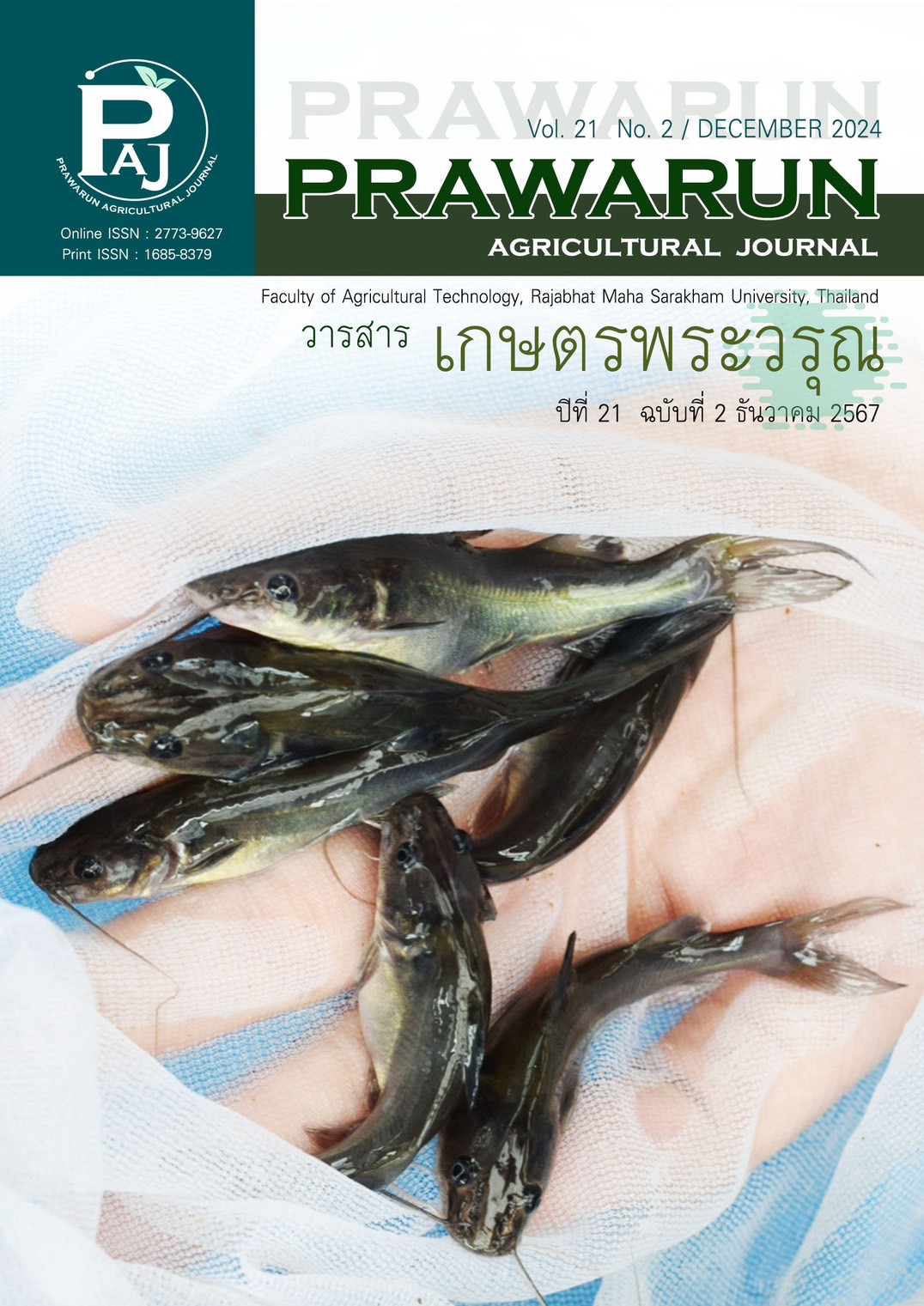Development of fruit tapioca pearl using response surface methodology
Main Article Content
Abstract
This research aimed to develop a fruit-based tapioca pearl product by varying the amount of arrowroot starch instead of using tapioca starch in the quantity range of 0-20 %. The factors studied included pineapple (0-100 %), banana (0-100 %), and guava (0-100 %), accounting for 10 % of the formula added to the tapioca pearls mixture, and the finished product quality was studied. The results showed that the variation of tapioca starch and arrowroot starch had a statistically significant (p≤0.05) effect on the hardness and springiness characteristics of the tapioca pearls product. The use of arrowroot starch (15 %) instead of tapioca starch in the formula resulted in the highest hardness, springiness, L* value, a* value, and b* value, being 22.22 g, 64.85 %, 23.0, 2.08, and 7.63, respectively. The response surface methodology showed that the coefficient of determination (R²) of the hardness, springiness, L* value, a* value, and b* value were 0.9859, 0.9991, 0.9980, 0.7226, and 0.9749, respectively. The most suitable formula for developing fruit-based tapioca pearls was 19.50 % pineapple, 29.57 % banana, and 50.93 % guava. The nutritional value of 100 grams of the fruit-based tapioca pearl product showed a total energy of 149.76 kcal, 3.27 % protein, 1.11 % fat, 3.60 % fiber, and 30.99 % carbohydrates. The microbial qualities found that the total plate count and the yeast and mold were less than 10³ CFU/g, and 10 CFU/g, respectively. However, the E. coli was not detected in the product.
Article Details
References
Association of Official Analytical Chemists AOAC. (2000). Official methods of analysis (17th ed.). Maryland, United States: Association Official Analytical Chemists.
Chantachoti, T. (2009). Dietary fiber of selected Thai fruits: chemical compositions, and associated antioxidant capacity. Thailand Science Research and Innovation. Accessed October 23, 2024. Retrieved from https://elibrary.tsri.or.th/project_content.asp?PJID=RDG5120067 (in Thai)
Derringer, G., & Suich, R. (1980). Simultaneous optimization of several response variables. Journal of Quality Technology, 12(4), 214-219. doi: 10.1080/00224065.1980.11980968
Jiménez-Escrig, A., & Sánchez-Muniz, F. J. (2000). Dietary fibre from edible seaweeds: chemical structure, physicochemical properties and effects on cholesterol metabolism. Nutrition Research, 20(4), 585-598. doi: 10.1016/S0271-5317(00)00149-4
Ketthongkam, P. (2023). The adhesion of starch to water chestnut in Tup Tim Grob (coated water chestnut pieces in coconut milk). Journal of Roi Kaensarn Academi, 8(6), 95-110. (in Thai)
Kutner, M., Nachtsheim, C., Neter, J., & Li, W. (2004). Applied linear statistical models (5th ed.). New York , United States: McGraw-Hill/Irwin.
Mahe, N., Awapak, D., & Pichairat, D. (2015). Optimization of high protein content protein hydrolysate extraction from hard clam (Meretrix casta) using response surface methodology. KKU Science Journal, 43(3), 425–438. (in Thai)
Malki, M. S. K., Wijesinghe, J. A. A. C., Ratnayake, R. H. M. K., & Thilakarathna, G. C. (2023). Characterization of arrowroot (Maranta arundinacea) starch as a potential starch source for the food industry. Heliyon, 9(9), e20033. doi: 10.1016/j.heliyon.2023.e20033
Montgomery, D. C. (2013). Design and analysis of experiments (8th ed.). New Jersey: United States: John Wiley & Sons, Inc.
Rattanajarusroj, T., & Srijesdaruk, V. (2015). Effect of processing conditions on resistance starch content from tapioca starch. Accessed October 23, 2024. Retrieved from https://rsucon.rsu.ac.th/files/proceedings/nation2015/G2-20.pdf
Rittiruengdej, P. (2003). Physical and chemical properties of arrowroot flour and its use in layer snacks (Master's thesis). Bangkok, Thailand: Kasetsart University. (in Thai)
Sangyojarn, P., Sangketkit, C., Kiatsakared, P., Namasthisong, T., Sarthiyakul, N., & Sanuksan, J. (2022). Physio-chemical properties of Tao Yai Mom flour and sensory properties of product. Accessed October 23, 2024. Retrieved from https://ird.rmuti.ac.th/2015/files/2562/File/
United States Department of Agriculture (USDA). (2019). Tapioca, pearl, dry. Food data central. Accessed December 1, 2024. Retrieved from https://fdc.nal.usda.gov/fdc-app.html#/food-details/169717/nutrients

